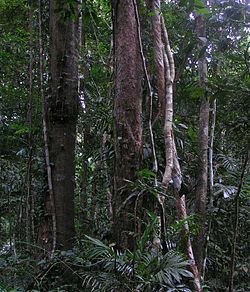Klimaxstadium
Klimaxstadium är inom ekologi att ett ekosystem genom ekologisk succession har nått ett stadium där artsammansättningen är stabil. Ett sådant ekosystem är sammansatt av de arter som är bäst anpassade till de genomsnittliga förhållandena i området.

Den första analysen av en succession som skulle kunna leda till ett klimaxstadium skrevs av den amerikanske botanikern Henry Cowles 1899. Begreppet myntades sedan av en annan amerikansk botaniker, Frederic Edward Clements, i början av 1900-talet.[1][2][3][4]
Stödet för teorierna kring klimaxstadium avtog under andra halvan av 1900-talet. Hypotesen stämde inte riktigt överens med de iakttagelser ekologer gjorde.[5] Efter en mindre omdefinition[förtydliga] på 1990-talet[6] har begreppet åter börjat användas bland ekologer.
Referenser
redigera- ^ Henry Chandler Cowles (1899). ”The Ecological Relations of the Vegetation on the Sand Dunes of Lake Michigan”. Botanical Gazette 27 (2): sid. 95-117.
- ^ Henry Chandler Cowles (1899). ”The Ecological Relations of the Vegetation on the Sand Dunes of Lake Michigan”. Botanical Gazette 27 (3): sid. 167-202.
- ^ Henry Chandler Cowles (1899). ”The Ecological Relations of the Vegetation on the Sand Dunes of Lake Michigan”. Botanical Gazette 27 (4): sid. 281-308.
- ^ Henry Chandler Cowles (1899). ”The Ecological Relations of the Vegetation on the Sand Dunes of Lake Michigan”. Botanical Gazette 27 (5): sid. 361-391.
- ^ Tobey, Ronald C. (1981). Saving the prairies: the life cycle of the founding school of American plant ecology, 1895–1955. Berkeley: University of California Press
- ^ Jonathan Roughgarden, Robert M. May, Simon A. Levin (red.) (1989). Perspectives in Ecological Theory. Princeton: Princeton University Press